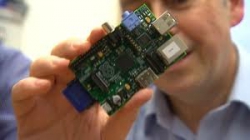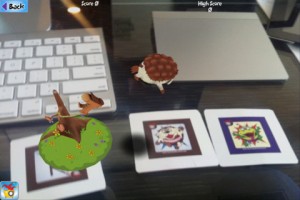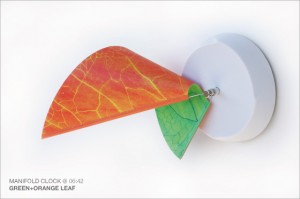iPad reviews
- "It's sort of funny that the only major thing those in the rumor business got wrong was the name of the new iPad," reports TechCrunch. "It's not the previously presumed 'iPad 3,' nor is it the 'iPad HD.' It's just the iPad. And that's what it will be from now on."
- During yesterday's Apple event, CEO Tim Cook emphasized the "Post-PC Revolution," noting that Apple has sold 315 iOS devices.
- Last quarter, Apple sold 15.4 million iPads. This was more than any PC manufacturer sold of their entire PC line worldwide: HP -- 15.1 million PCs, Lenovo -- 13 million, Dell -- 11.9 million, Acer -- 9.8 million.
- TechCrunch offers a positive review of the company's new tablet. The new iPad's display "makes everything look like a printed photograph." It seems fast. The 4G LTE will be faster than many broadband connections. The camera is "much, much, much, much, much better." And iPhoto will be fun to use.
- "You're going to see a lot more of this type of innovation," Tim Cook said. "We're just getting started."
- In a related first impressions post: "When I pulled up a nice, high resolution photograph on the iPad 3rd-gen, I genuinely could not tell the difference between what I was seeing onscreen, and a nice, beautifully shot, well-printed, glossy photograph. It was seriously to that level," comments Ryan Block, co-founder of gdgt.
Original Sources: techcrunch.com | gdgt.com
3D in Digital Darkroom: Annenberg Space for Photography
 [Philip Lelyveld comment: the current show at the Annenberg Space for Photography in Century City, CA. includes anaglyph 3D imagery, both in the gallery and on the website. ]
[Philip Lelyveld comment: the current show at the Annenberg Space for Photography in Century City, CA. includes anaglyph 3D imagery, both in the gallery and on the website. ]
from the Annenberg website:
"Use the free 3D glasses you receive when you visit "Digital Darkroom" to enjoy content from the exhibit on our website - just look for the image above. Click here to view 3D images on our blog andhere to see the 3D images from our print show."
See the website for more information and gallery hours here:
Original 1953 ‘Titanic’ Comes to Blu-ray
 In commemoration of the 100th anniversary of the sinking of the Titanic — and in time for the April 4 release of James Cameron’s Titanic 3D in theaters — 20th Century Fox Home Entertainment will release the 1953 film Titanic on Blu-ray April 3 (order date March 7) at $24.99.
In commemoration of the 100th anniversary of the sinking of the Titanic — and in time for the April 4 release of James Cameron’s Titanic 3D in theaters — 20th Century Fox Home Entertainment will release the 1953 film Titanic on Blu-ray April 3 (order date March 7) at $24.99.
The original “Titanic” film won the Academy Award for Best Writing, Story and Screenplay and was nominated for Best Art Direction — Set Decoration, Black-and-White. The film stars Clifton Webb, Barbara Stanwyck, Robert Wagner and Audrey Dalton in the story of a woman (Stanwyck) who is hoping to escape upper-crust society with her two children, while her husband (Webb) boards the ship hoping to reconcile the family and unaware of the fateful events that will take place on the doomed ship.
The special features include a commentary by film critic Richard Schickel; and another by cinematographer Michael D. Lonzo, Dalton, Wagner and historian Sylvia Stoddard; two MovieTone News pieces on Titanic; the audio essay “Titanic Aftermath,” by Stoddard; the theatrical trailer and a still gallery.
A Titanic miniseries also airs on ABC starting April 14, and Entertainment One will release a two-DVD set ($29.98), a two-disc Blu-ray ($34.98) and a Blu-ray/DVD combo pack ($39.98) April 24.
See the original post here:
Gimme Pi: Why I want a tiny computer that doesn’t do anything
 ... When my dad bought us anApple IIe back in 1983, I enjoyed making stuff on that too. I had no idea what I was doing, but when I was 13, a blank screen and a blinking green cursor didn't represent frustration: It meant possibility. That's why I'm excited to get my hands on a Raspberry Pi -- a diminutive, $35 computer with no apps, no programs, no monitor/keyboard, no Facebook and endless possibilities. ...
... When my dad bought us anApple IIe back in 1983, I enjoyed making stuff on that too. I had no idea what I was doing, but when I was 13, a blank screen and a blinking green cursor didn't represent frustration: It meant possibility. That's why I'm excited to get my hands on a Raspberry Pi -- a diminutive, $35 computer with no apps, no programs, no monitor/keyboard, no Facebook and endless possibilities. ...
Today's gadgets, however, aren't very condusive to tinkering. Laptops are pretty well sealed up; cracking open your iPad or smartphone means voiding the warranty and trying to monkey with the tiniest ribbon cables you've ever seen. Raspberry Pi is a neat project looking to bring a little bit of that creativitity and "let's see what's under the hood" chutzpah back to computing. ...
The initial Model B version -- a credit card-sized board with two USB ports, an Ethernet port, audio port, HDMI port, 700 Mhz CPU and 256 MB RAM -- went on sale March 1 and sold out within hours. ...
3D-Porn Director Dominic Ford Launches Adult Magazine for iPad
 The lightning-fast growth of technology over the past decade has irrevocably altered how pornography is produced, distributed and consumed. The interwebs certainly put a stake in the heart of dead-tree porn periodicals, but now there’s a new twist: a dirty mag for your iPad.
The lightning-fast growth of technology over the past decade has irrevocably altered how pornography is produced, distributed and consumed. The interwebs certainly put a stake in the heart of dead-tree porn periodicals, but now there’s a new twist: a dirty mag for your iPad.
Launching this month, Adult magazine is the brainchild of 3D-porn director/producer Dominic Ford, who serves as editor-in-chief of the new venture. ...
Beyond the porn content, though, Ford says monthly issues will also include erotic fiction, horoscopes, advice columns and other lifestyle content. He intends for the magazine to pay for itself with advertising. (For now, its free and available only on the iPad.) ...
The first issue includes an interview with French porn god Francois Sagat (above) but Ford is clear that Adult is more than just a skin mag. “We’ll be interviewing RuPaul’s Drag Race contestants and talking about music and other topics that appeal to any gay man,” he says. ...
Read the full story here:
MushABellies Come to Life With 3D Augmented-Reality Game
 More than 4.5 million MushABelly® plush collectibles have already captured hearts worldwide. Now all new MushABelly collectibles will include a cutting-edge 3D augmented-reality game that makes kids' favorite MushABellies come to life, right in their own living room, as they watch "Magic Before Your Eyes"™.
More than 4.5 million MushABelly® plush collectibles have already captured hearts worldwide. Now all new MushABelly collectibles will include a cutting-edge 3D augmented-reality game that makes kids' favorite MushABellies come to life, right in their own living room, as they watch "Magic Before Your Eyes"™.
Augmented-reality (AR) technology is the hottest trend in apps, and Jay@Play is the first toy manufacturer to combine plush with a game experience for the entire family. MushABellies' new 3D augmented-reality game, powered by Jay@Play's ToyTube Network™, blends the game world and the real world using a smartphone device and exclusive, patented augmented reality from Gravity Jack. ...
Using a Toy Tube Tracker Card, launch MushABelly Mungo Monkey at the target barrel to score lots of banana points. Quickly tap them with your fingertip to earn more points. Move the Toy Tube Tracker Cards to make the game more challenging. ...
Read the full article here:
Ten Technology Trends that Will Change the World in the Next Ten Years
 Dave Evans, Cisco's Chief Futurologist:
Dave Evans, Cisco's Chief Futurologist:
The number of Internet-connected things will reach 50 billion by 2020
By 2015, 91% of Internet data will be Video
By 2020, one-third of all data will live in or pass through the cloud
Network speeds will increase three million times in the next 10 years
Middle East - February 12, 2012: At Cisco Live 2012, an annual flagship event in Europe, Dave Evans, Cisco's chief futurist and chief technologist for the Cisco Internet Business Solutions Group (IBSG), outlined what he sees to be the top 10 technology trends that will change the world in the next decade. According to him, 3D printers, sensor networks, virtual humans, and other technologies under development will drastically change our world in the decade to come.
Trend 1: The Internet of Things
The Internet is the most powerful communications tool in history. The Web has evolved from informational and transactional mediums, to a social web that enables immediate knowledge sharing and wisdom of a crowd. Today, more things are connected to the Internet than people on the planet. We are at an inflection point-a new beginning-an era of dramatic and accelerated innovation of new technology applications that will benefit humanity.
The number of Internet-connected things will reach 50 billion by 2020, which equates to more than six devices for every person on Earth. Many people in the developed world already have three or more full-time devices connected to the Internet when factoring in PCs, smartphones, tablets, television devices and the like. Next up are sensor networks, using low-power sensors that "collect, transmit, analyze and distribute data on a massive scale.
Trend 2: The Zettaflood Is Coming
About 5 exabytes of unique information were created in 2008. That's one billion DVDs. Currently 1.2 zettabytes are being created, with one zettabyte equal to 1,024 exabytes. This is the same as every person on Earth tweeting for 100 years, or 125 million years of your favorite one-hour TV show. The love of high-definition video accounts for much of the increase. By Cisco's count, 91% of Internet data in 2015 will be video.
Trend 3: Wisdom of the cloud
By 2020, one-third of all data will live in or pass through the cloud. Global cloud services revenue will jump 20% per year, and IT spending on innovation and cloud computing could top $1 trillion by 2014. With the cloud comes the ability to mine human knowledge and to put an intelligent front on it.
In addition to video, the computing power of the cloud delivered to endpoint devices changes our ability to communicate with things like real-time translation. More intelligence is expected to be built into communication. Things like contextual and location-based information.
With an always-connected device, the network can be more granular with presence information, tapping into a personal sensor to know that a person's asleep, and route an incoming call to voicemail. Or knowing that person is traveling at 60 mph in a car, and that this is not the time for a video call.
Trend 4: The Next Net
Network speeds in the home have increased by 170,000 times since 1990, they will continue to increase three million times in the next 10 years. In line with this, networks will scale to meet future demands.
Trend 5: The World is Flat... So Is Your Technology
With always-on connectivity, social networking has the power to change cultures. Social influences will continue to move rapidly between cultures. In 10 years anyone will be able to broadcast anywhere on any device, providing unprecedented transparency.
Trend 6: The Power of Power
The human population also continues to grow, and Evans estimates that a city with one million inhabitants will be built every month over the next two decades. More efficient methods to power those cities are becoming a necessity, particularly solar energy.
In the next decade people will be able to harness alternative energy and become smarter in our use of power.
Trend 7: It's All About You
More items will move from physical to virtual. Today, people download e-books and movies, rather than bound books and DVDs.
Examples on that are gesture-based computing, interactive TV, facial recognition, and always on technologies that will soon be able to be incorporated into glasses and contact lenses - all of which will be connected to the cloud and our social graphs for personalized content streaming.
Trend 8: The Next Dimension
Virtual humans, both physical (robots) and online avatars will be added to the workforce.
Between now and then, augmented reality and gesture-based computing will enter classrooms, medical facilities and communications, and transform them as well.
Trend 9: Another Family Tree
In the next 10 years, medical technologies will grow vastly more sophisticated as computing power becomes available in smaller forms. It is predicted that it will be possible to make a conscious computer with super human intelligence before 2020.
Trend 10: You... Only Better
According to Evans, humans are crossing the threshold from discovery into controlling our own destiny, where technology results in fundamental changes to us as a society and species.
In July 2009 -- Spanish researchers discovered substance for photographic memory. In October 2009 -- Italian and Swedish scientists developed the first artificial hand with feeling. In March 2010 -- Retina implanted restore vision to blind patients. In June 2011 -- Texas Heart Institute developed a "spinning" heart with no pulse, no clogs and no breakdowns.
While the early use of these technologies were to repair unhealthy tissue or fix the consequences of brain injury, eventually designer enhancements will be available to all. Ultimately, humans will use so much technology to mend, improve or enhance their bodies to live much longer - up to 200 years in the near future.
Read the original post here:
Crayola Dazzles Kids With Colorful New Activities That Inspire Fun and Creativity
Crayola is helping kids create sidewalk art in amazing new ways - with awesome 3D and kaleidoscope effects! With Crayola's 3D Kaleidoscope Giant Chalk, kids simply draw designs on the sidewalk, put on the 3D kaleidoscope glasses and watch as their creations pop off the ground and become a unique twirling design right before their eyes.
Read the full press release here.
Manifold Clock: A 3D timepiece for math geeks
The Manifold Clock from Studio Ve doesn't require special glasses. It didn't take a crew of 300 and a Hollywood budget to create. It's 3D in its purest form: real life.
The Manifold Clock doesn't just tell time with flat hands, it expresses it with ever-changing shapes created by a flexible sheet of Tyvek attached between the hands. Every minute looks slightly different.
There's some delightful mathematical geekiness behind all of this. The design uses the concept of Riemann surfaces.
If you're a math nerd, you probably already know all about Riemann surfaces. Others can brush up with the Kickstarter video below.
A $45 pledge will get you a Manifold Clock with a few different colors to choose from. A jumbo-size clock is also available for $100. If you love the concept, but don't want to sacrifice wall space, a $1 pledge gets you the screen saver version for your computer.
The Manifold Clock has already topped its $15,000 Kickstarter goal. That means that math classrooms and geek abodes will be sporting the beautifully nerdy clocks soon after they ship in the spring.
Watch the video at the original post here.
How Martin Scorsese Pulls Off Hugo’s Nostalgia
 The trouble I have with most of the retro-tech material in the contemporary art galleries is that it ends up feeling desiccated, with inventions that were never really meant to be contemplated as freestanding works of art now isolated from the history that gave them their meaning. What might originally have been a technological marvel—a figure that moves, a machine that speaks—becomes at best a historical specimen, now experienced only as a Dadaist object, a variation on one of Duchamp’s Readymades. The secret of Scorsese’s success in Hugo has everything to do with the inherently impure and unstable nature of the movies, where art can be precipitated by—can maybe even be a by-product of—technological innovation. Say what you will, that’s not possible in an art gallery, where purity and stability are the standard and traditions have to be transformed gradually, from within.
The trouble I have with most of the retro-tech material in the contemporary art galleries is that it ends up feeling desiccated, with inventions that were never really meant to be contemplated as freestanding works of art now isolated from the history that gave them their meaning. What might originally have been a technological marvel—a figure that moves, a machine that speaks—becomes at best a historical specimen, now experienced only as a Dadaist object, a variation on one of Duchamp’s Readymades. The secret of Scorsese’s success in Hugo has everything to do with the inherently impure and unstable nature of the movies, where art can be precipitated by—can maybe even be a by-product of—technological innovation. Say what you will, that’s not possible in an art gallery, where purity and stability are the standard and traditions have to be transformed gradually, from within.
Working in a medium that is nothing if not forward looking, Scorsese can afford to indulge in a nostalgia that from the very different perspective of the art gallery amounts to little more than tradition reduced to kitsch. With Hugo, Scorsese has reintegrated the technological exhilaration of times past into a work of cinematic art we accept as absolutely alive in the present. We see everything—the automaton’s clockwork body, Méliès elaborately hand-colored movies, the spectacle of 1930s Paris—through Asa Butterfield’s young, avid eyes.
Read the full essay here
Pages
- About Philip Lelyveld
- Mark and Addie Lelyveld Biographies
- Presentations and articles
- Tufts Alumni Bio
